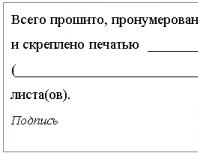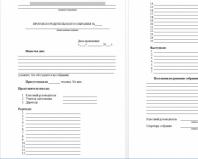MMA 250 causes of malfunction. Schematic diagram of a welding inverter: let's look at the details. Processes occurring in the electrical circuit of a welding inverter
The circuit is fundamentally different from the design of its predecessor - the welding transformer. The basis of the design of the previous welding machines there was a step-down transformer, which made them bulky and heavy. Modern welding inverters, thanks to the use of advanced developments in their production, are lightweight and compact devices characterized by wide functionality.
The main element of the electrical circuit of any welding inverter is a pulse converter that produces high frequency current. It is thanks to this that the use of an inverter makes it possible to easily ignite the welding arc and maintain it in a stable state throughout the welding process. The welding inverter circuit, depending on the model, may have certain features, but the principle of its operation, which will be discussed below, remains unchanged.
What types of inverters are available on the modern market?
For a certain type of welding, you should choose the right inverter equipment, each type of which has a specific electrical circuit and, accordingly, special technical characteristics and functionality.
Inverters that produce modern manufacturers, can be equally successfully used both on manufacturing enterprises, and in everyday life. Developers are constantly improving electrical circuit diagrams inverter devices, which allows you to provide them with new functions and improve them specifications.

Inverter devices as the main equipment are widely used to perform the following technological operations:
- consumable and non-consumable electrodes;
- welding using semi-automatic and automatic technologies;
- plasma cutting, etc.
In addition, inverter devices are the most effective type equipment that is used for welding aluminum, stainless steel and other difficult-to-weld metals. Welding inverters, regardless of the features of their electrical circuit, allow you to obtain high-quality, reliable and neat welds made using any technology. At the same time, what is important is that the compact and not too heavy inverter machine, if necessary, can be easily moved at any time to the place where welding work will be performed.

What does the design of a welding inverter include?
The welding inverter circuit, which determines its technical characteristics and functionality, includes the following required elements, How:
- block providing electrical power the power part of the device (it consists of a rectifier, a capacitive filter and a nonlinear charging circuit);
- power part, made on the basis of a single-cycle converter (this part of the electrical circuit also includes power transformer, secondary rectifier and output choke);
- power supply unit for elements of the low-current part of the electrical circuit of the inverter apparatus;
- PWM controller, which includes a current transformer and a load current sensor;
- block responsible for thermal protection and control of cooling fans (this block of the circuit diagram includes inverter fans and temperature sensors);
- controls and indications.
How does a welding inverter work?
Current shaping great strength, which creates an electric arc to melt the edges of the parts being joined and the filler material, is what any welding machine is designed for. For the same purposes, an inverter apparatus is also needed, which allows the generation of welding current with a wide range of characteristics.
In its simplest form, the principle looks like this.
- Alternating current with a frequency of 50 Hz from a regular electrical network is supplied to the rectifier, where it is converted into direct current.
- After the rectifier, the direct current is smoothed using a special filter.
- From the filter, direct current flows directly to the inverter, whose task is to convert it again into alternating current, but at a higher frequency.
- After this, using a transformer, the voltage of the alternating high-frequency current is reduced, which makes it possible to increase its strength.

In order to understand the importance of each element of the electrical circuit diagram of an inverter device, it is worth considering its operation in more detail.
Processes occurring in the electrical circuit of a welding inverter
The circuit allows you to increase the current frequency from the standard 50 Hz to 60–80 kHz. Due to the fact that high-frequency current is subject to regulation at the output of such a device, compact transformers can be effectively used for this. An increase in the frequency of the current occurs in that part of the inverter electrical circuit where the circuit with powerful power transistors is located. As you know, only direct current is supplied to transistors, which is why a rectifier is needed at the input of the device.

Schematic diagram of the factory welding inverter "Resanta" (click to enlarge)

Inverter circuit from German manufacturer FUBAG with a number additional functions(click to enlarge)

An example of a circuit diagram of a welding inverter for self-made(click to enlarge)
The electrical circuit diagram of the inverter device consists of two main parts: the power section and the control circuit. The first element of the power section of the circuit is a diode bridge. The task of such a bridge is precisely to transform alternating current to permanent.
In the direct current converted from alternating current in the diode bridge, pulses may occur that need to be smoothed out. To do this, a filter consisting of capacitors of predominantly electrolytic type is installed after the diode bridge. It is important to know that the voltage that comes out of the diode bridge is approximately 1.4 times greater than its value at the input. When converting AC to DC, rectifier diodes become very hot, which can seriously affect their performance.

To protect them, as well as other elements of the rectifier from overheating, radiators are used in this part of the electrical circuit. In addition, a thermal fuse is installed on the diode bridge itself, the task of which is to turn off the power supply if the diode bridge has heated up to a temperature exceeding 80–90 degrees.
High-frequency interference generated during operation of the inverter device can enter the electrical network. To prevent this from happening, a filter is installed in front of the rectifier block of the circuit electromagnetic compatibility. Such a filter consists of a choke and several capacitors.

The inverter itself, which converts direct current into alternating current, but with a much higher frequency, is assembled from transistors using an “oblique bridge” circuit. The switching frequency of transistors, due to which the alternating current is generated, can be tens or hundreds of kilohertz. The high-frequency alternating current thus obtained has a rectangular amplitude.
A voltage-reducing transformer installed behind the inverter unit allows you to obtain a current of sufficient strength at the output of the device so that you can effectively perform welding work with its help. In order to obtain direct current using an inverter apparatus, a powerful rectifier, also assembled on a diode bridge, is connected after the step-down transformer.

Inverter protection and control elements
Several elements in its fundamental design allow avoiding the influence of negative factors on the operation of the inverter. electrical diagram.
To ensure that transistors that convert direct current into alternating current do not burn out during their operation, special damping (RC) circuits are used. All electrical circuit blocks that operate under heavy load and become very hot are not only provided with forced cooling, but are also connected to temperature sensors that turn off their power if their heating temperature exceeds a critical value.

Due to the fact that the filter capacitors, after being charged, can produce a high current, which can burn the inverter transistors, the device must be provided with smooth start. For this purpose, stabilizers are used.
The circuit of any inverter has a PWM controller, which is responsible for controlling all elements of its electrical circuit. From PWM controller electrical signals are supplied to a field-effect transistor, and from it to an isolation transformer, which simultaneously has two output windings. The PWM controller, through other elements of the electrical circuit, also supplies control signals to the power diodes and power transistors of the inverter unit. In order for the controller to effectively control all elements of the inverter's electrical circuit, it is also necessary to supply electrical signals to it.
To generate such signals, an operational amplifier is used, the input of which is supplied with the output current generated in the inverter. If the values of the latter diverge from the specified parameters, the operational amplifier generates a control signal to the controller. In addition, the operational amplifier receives signals from all protective circuits. This is necessary so that he can disconnect the inverter from the power supply at the moment when a critical situation arises in its electrical circuit.
Advantages and disadvantages of inverter-type welding machines
The devices that replaced the usual transformers have a number of significant advantages.
- Thanks to a completely different approach to the formation and regulation of welding current, the weight of such devices is only 5–12 kg, while welding transformers weigh 18–35 kg.
- Inverters have very high efficiency (about 90%). This is explained by the fact that they spend significantly less excess energy on heating components. Welding transformers, Unlike inverter devices, they get very hot.
- Due to such high efficiency, inverters consume 2 times less electrical energy than conventional welding transformers.
- The high versatility of inverter machines is explained by the ability to regulate the welding current with their help. within wide limits. Thanks to this, the same device can be used for welding parts made of different metals, as well as for welding using different technologies.
- Majority modern models inverters are equipped with options that minimize the impact of welder errors on technological process. Such options, in particular, include “Anti-stick” and “Arc Force” (fast ignition).
- Exceptional stability of the voltage supplied to the welding arc is ensured by the automatic elements of the inverter electrical circuit. In this case, automation not only takes into account and smoothes out differences in input voltage, but also corrects even such interference as the attenuation of the welding arc due to strong wind.
- Welding using inverter equipment can be performed with any type of electrode.
- Some models of modern welding inverters have a programming function, which allows you to accurately and quickly configure their modes when performing a certain type of work.
Many argue that high-quality amateur photography from a phone is impossible, or at least difficult under non-ideal conditions. Probably many professional photographers would be okay with this
timber  1 The construction of a log house is preceded by the construction of a foundation. We talked about the basics of foundation calculations and methods for pouring them earlier. If your foundation is ready, you can safely begin assembling the house.
1 The construction of a log house is preceded by the construction of a foundation. We talked about the basics of foundation calculations and methods for pouring them earlier. If your foundation is ready, you can safely begin assembling the house.
Moving boxes  Whatever the move, office or home, people moving always face the same problem - lack of packing boxes for moving. It’s amazing, but in our age of high technology
Whatever the move, office or home, people moving always face the same problem - lack of packing boxes for moving. It’s amazing, but in our age of high technology
Blinds for plastic windows  From time to time we do renovations in our apartments and houses. We all go through the exhausting stages of choosing building materials, and then the most labor-intensive renovation of a house or apartment. But sometimes, after all
From time to time we do renovations in our apartments and houses. We all go through the exhausting stages of choosing building materials, and then the most labor-intensive renovation of a house or apartment. But sometimes, after all
T-shirts  Every fashionista knows perfectly well that first we create a basic wardrobe, and then, with the help of various details and accessories, we can change it beyond recognition. T-shirts are just right
Every fashionista knows perfectly well that first we create a basic wardrobe, and then, with the help of various details and accessories, we can change it beyond recognition. T-shirts are just right
Mounted and trailed disc harrow  Technical support in the farm of a modern farmer, it certainly includes means for cultivating the land. For this purpose, cultivators and walk-behind tractors are used, which, depending on the model, can
Technical support in the farm of a modern farmer, it certainly includes means for cultivating the land. For this purpose, cultivators and walk-behind tractors are used, which, depending on the model, can
Linoleum  In the USSR, sprats had a pronounced Baltic accent. They were caught mainly in the Baltic Sea, smoked, canned and sent to all corners of the vast country. Even with today's abundance of delicacies
In the USSR, sprats had a pronounced Baltic accent. They were caught mainly in the Baltic Sea, smoked, canned and sent to all corners of the vast country. Even with today's abundance of delicacies
Letterpress  This device is called an Otolaryngological head mirror. It is needed so that the doctor can examine in detail what is going on in the patient’s ears, nose and throat. An ENT doctor wears such a device
This device is called an Otolaryngological head mirror. It is needed so that the doctor can examine in detail what is going on in the patient’s ears, nose and throat. An ENT doctor wears such a device
Laminate  Laminate is considered not very reliable and durable coating. And in vain. There are types of laminate flooring that can cope well not only with the role of flooring in a house or apartment, but also in places where
Laminate is considered not very reliable and durable coating. And in vain. There are types of laminate flooring that can cope well not only with the role of flooring in a house or apartment, but also in places where
Business cards  Business card printing is exciting activity, which can interest everyone creative person. After all, young people in our country generally do not seek to engage in any kind of activity.
Business card printing is exciting activity, which can interest everyone creative person. After all, young people in our country generally do not seek to engage in any kind of activity.
The device is made using IGBT or (half-bridge) technology.

With a complaint from the owner that the electrode is sticking and does not want to weld. After connecting to the network
and attempts to weld the part, nothing worked. And after changing the welding current to a higher one, the welding began to smoke and I heard an electric crackling sound. The owner said that the cause of the breakdown was not caused by right choice welding current for the electrode.
Attention: you perform all repair and restoration work on the welding inverter at your own peril and risk.
After disassembly, it was decided to unscrew and check the power supply.

A burnt 150 Ohm 10W resistor was found.


The diode bridge at 100V 35A and the relay at 24 35A turned out to be working.

And in the power supply a swollen capacitor 470 µF x 450 V was found which was replaced.



This board has:
- Driver power keys. (everything possible is checked on this scarf; the resistance should be no more than 10 ohms).
- Power keys.
- 24 V power supply (transistor K2611 or its equivalent and its body kit are checked, see photo).
- Master oscillator. (all field-effect transistors are checked, you can check by turning on welding; when you turn it on and off, a squeak from the generator should appear).
How to check power keys
IRG4PC50UD keys or its equivalents are installed here. Using a multimeter in diode testing mode, you need to ring the legs of the transistor “E” and “C”; in one direction they should ring, but in the other direction they should not ring; the transistor needs to be discharged (short circuit all legs). On legs "G" and "E" the resistance should be infinite, regardless of polarity.

Next you need to apply 12 volts to the leg “G” - “+” and to the “E” “-” direct current. and ring the legs “C” and “E” they should ring. Next, you need to remove the charge from the transistor (short circuit the legs). Legs "C" and "E" should have infinite resistance. If all these conditions are met, then the transistor is working, and so you need to check all the transistors.




